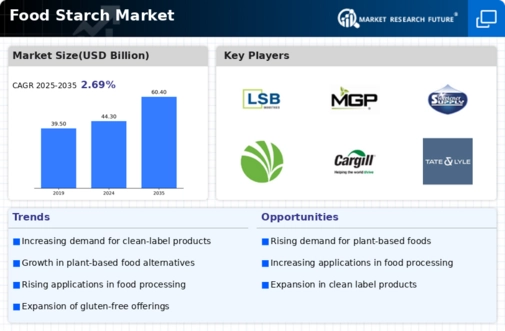Growth in the Beverage Industry
The Food Starch Market is also benefiting from the growth in the beverage sector, particularly in the development of non-alcoholic drinks. Starches are utilized as stabilizers and clouding agents in various beverages, enhancing their visual appeal and texture. The non-alcoholic beverage market is projected to expand at a rate of around 5 percent annually, driven by the rising health consciousness among consumers. This growth presents a substantial opportunity for food starch manufacturers to innovate and develop new formulations that cater to the evolving preferences of health-oriented consumers. As a result, the demand for food starches in beverage applications is likely to increase, further propelling the market.
Increasing Demand for Processed Foods
The Food Starch Market is experiencing a notable surge in demand for processed foods, driven by changing consumer lifestyles and preferences. As urbanization continues to rise, more individuals are seeking convenient meal options that require minimal preparation time. This trend is reflected in the increasing use of food starches as thickening agents, stabilizers, and texturizers in various processed food products. According to recent data, the processed food sector is projected to grow at a compound annual growth rate of approximately 4.5 percent over the next five years. This growth is likely to bolster the food starch market, as manufacturers increasingly incorporate starches to enhance the texture and shelf-life of their offerings.
Rising Health Awareness and Functional Foods
The Food Starch Market is witnessing a shift towards health-conscious eating habits, leading to an increased demand for functional foods. Consumers are becoming more aware of the nutritional benefits of food ingredients, including starches that offer health benefits such as improved digestion and lower glycemic indices. This trend is reflected in the growing popularity of products fortified with resistant starches, which are known to support gut health. Market analysis indicates that the functional food segment is expected to grow at a rate of approximately 6 percent over the next few years, suggesting that food starch manufacturers will need to adapt their offerings to align with these health trends.
Technological Advancements in Starch Production
The Food Starch Market is being transformed by technological advancements in starch production processes. Innovations such as enzymatic modification and high-temperature processing are enhancing the efficiency and quality of starches. These advancements not only improve the yield of starch extraction but also enable the development of specialty starches tailored for specific applications. As the food industry increasingly seeks to optimize production processes and reduce costs, the adoption of these technologies is likely to accelerate. Recent reports indicate that the market for modified starches is expected to grow significantly, potentially reaching a valuation of several billion dollars by 2027, underscoring the importance of technological progress in shaping the future of the food starch market.
Expansion of the Bakery and Confectionery Sector
The Food Starch Market is significantly influenced by the expansion of the bakery and confectionery sector. Starches play a crucial role in improving the texture, moisture retention, and overall quality of baked goods and confections. As consumer preferences shift towards indulgent and premium products, the demand for high-quality starches is expected to rise. Recent statistics indicate that the bakery segment alone is anticipated to account for over 30 percent of the total food starch consumption by 2026. This trend suggests that manufacturers will increasingly rely on food starches to meet the evolving demands of consumers seeking innovative and appealing bakery products.

















Leave a Comment